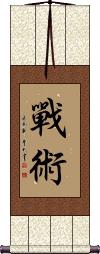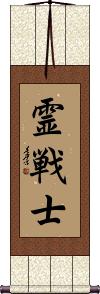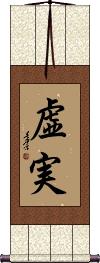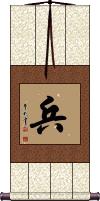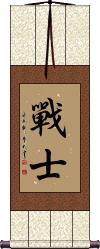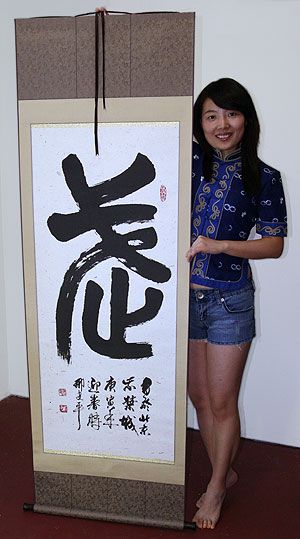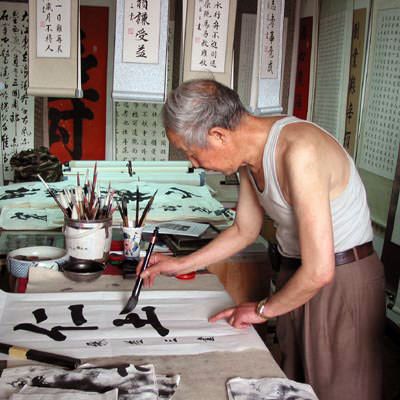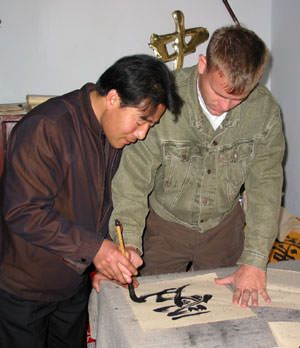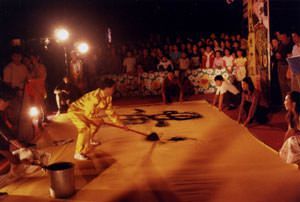Many custom options...
And formats...

Warfare in Chinese / Japanese...
Buy a Warfare calligraphy wall scroll here!
Personalize your custom “Warfare” project by clicking the button next to your favorite “Warfare” title below...
Tactics of War
戰術 can mean “tactics of war,” “battle tactics” or simply “tactics” (being that warfare is implied in that English word).
This word is written in the ancient and traditional form of Chinese, Japanese, and Korean.
![]()
In modern Japan, the first character has been simplified or modified. If you want the modern Japanese Kanji version, just click on that character shown to the right.
Spiritual Warrior
Kyojitsu: Falsehood and Truth
虚実 is a Japanese word that means “falsehood [and] truth” or “fiction [and] fact.”
This concept is used in warfare, gameplay, and martial arts strategies. 虚実 can be a strategy of real and/or deceptive moves. This gets to some Sun Tzu Art of War stuff where in warfare a strategic move is either a real and serious move or it is a deceptive blow.
Let's explore each character in more depth:
虚 was originally written 虛 (there is a very subtle difference in the strokes at the bottom of the character) and means unpreparedness, falsehood, emptiness, void, abstract theory, empty or unoccupied, diffident or timid, false, humble or modest, virtual, or in vain.
In the Buddhist context, 虛 represents the Pali/Sanskrit word “śūnya,” meaning empty, vacant, unreal, unsubstantial, untrue, space, humble, or in vain.
In ancient Eastern/Chinese astronomy, 虛 represents the “Emptiness” constellation (one of the 28 mansions in the sky).
実 was originally 實 in Chinese (they currently write it as 实 in Simplified Chinese) with the meaning, truth, reality, sincerity, honesty, fidelity, and substance.
The Buddhist context is similar, adding real, true, honest, really, solid, definitely, sincere, solid, fixed, full, to fill, fruit, kernel, verily, in fact, the supreme fact, or ultimate reality to the definition.
Soldiers
兵 can be used to express soldiers, troops, a force, an army, weapons, arms, military, warfare, tactics, strategy, or warlike.
The final meaning depends on context. It's also part of the Chinese title for the Terracotta soldiers. In fact, this character is usually used in compound words (words of more than one character). Sometimes this single character is the title used for the pawns in a chess game (in a related issue, this is also a nickname for soldiers with the rank of Private).
Sun Tzu - Art of War
military strategy, tactics, and procedure
孫子兵法 is the full title of the most famous book of military proverbs about warfare.
The English title is “Sun Tzu's The Art of War.”
The last two characters have come to be known in the west as “The Art of War,” but a better translation would be “military strategy and tactics,” “military skills” or “army procedures.”
Note: Sometimes the author's name is Romanized as “Sun Zi” or “Sunzi.”
It's written the same in Chinese, Japanese Kanji, and Korean Hanja.
Fighter
Warrior / Soldier
戰士 is how to write “fighter” in Chinese, ancient Japanese Kanji, and old Korean Hanja.
The first character means war, warfare, or battle.
The second character means soldier, officer, man, or pawn.
戰士 can also mean soldier or warrior. Usually this will be read as “fighter” or “one who fights.” 戰士 is an odd selection for a wall scroll unless you are a boxer, ultimate fighter, or otherwise participate in combat sports.
Other translations include combatant or champion.
![]() Note that after WWII, the first Kanji was reformed/simplified. This modern Japanese version is shown to the right. If you want this version, click on the Kanji to the right, instead of the button above.
Note that after WWII, the first Kanji was reformed/simplified. This modern Japanese version is shown to the right. If you want this version, click on the Kanji to the right, instead of the button above.
These search terms might be related to Warfare:
Antiwar / Anti-War
Art of War
Art of War: 5 Points of Analysis
Fighting Spirit
God of War
Guandi: God of War
Hachiman: God of War
Hand-to-Hand Fighting / Grappling
It is Better to Be a Warrior in a Garden Than a Gardener in a War
Strive / Struggle
Sun Tzu - Art of War
Tactics of War
War
War Machine
Warrior Saint / Saint of War
Not the results for warfare that you were looking for?
Below are some entries from our dictionary that may match your warfare search...
| Characters If shown, 2nd row is Simp. Chinese |
Pronunciation Romanization |
Simple Dictionary Definition |
兵 see styles |
bīng bing1 ping hei / he へい |
More info & calligraphy: Soldiers(1) (common) soldier; rank and file; (2) army; troops; (3) warfare; strategy; (personal name) Minetoshi |
訣 诀 see styles |
jué jue2 chüeh satoshi さとし |
to bid farewell; tricks of the trade; pithy mnemonic formula (e.g. Mao Zedong's 16-character mantra 十六字訣|十六字诀 on guerrilla warfare) (male given name) Satoshi to branch off |
兵戈 see styles |
bīng gē bing1 ge1 ping ko heika / heka へいか |
weapons; arms; fighting; war swords; arms; warfare weapons |
夜戦 see styles |
yasen やせん |
night warfare |
守戦 see styles |
shusen しゅせん |
war of defense; war of defence; defensive fight; defensive warfare |
心戰 心战 see styles |
xīn zhàn xin1 zhan4 hsin chan |
psychological warfare; (literary) to be inwardly terrorized |
戎馬 戎马 see styles |
róng mǎ rong2 ma3 jung ma juuba / juba じゅうば |
warhorse; armed forces; troops; (fig.) war; warfare (rare) (See 軍馬) warhorse |
戦乱 see styles |
senran せんらん |
warfare; the maelstrom of war; disorder brought about by war |
戰禍 战祸 see styles |
zhàn huò zhan4 huo4 chan huo |
disastrous conflict; bloody warfare |
核戰 核战 see styles |
hé zhàn he2 zhan4 ho chan |
nuclear warfare |
海戰 海战 see styles |
hǎi zhàn hai3 zhan4 hai chan |
sea warfare; naval battle |
混戰 混战 see styles |
hùn zhàn hun4 zhan4 hun chan |
chaotic warfare; confused fighting; melee; to join in such fighting |
游擊 游击 see styles |
yóu jī you2 ji1 yu chi |
guerrilla warfare |
獵潛 猎潜 see styles |
liè qián lie4 qian2 lieh ch`ien lieh chien |
anti-submarine (warfare) |
空戰 空战 see styles |
kōng zhàn kong1 zhan4 k`ung chan kung chan |
air war; air warfare |
陸戰 陆战 see styles |
lù zhàn lu4 zhan4 lu chan |
(military) to fight on land; ground warfare |
ゲリラ see styles |
gerira ゲリラ |
(1) guerrilla; guerrilla warfare; (can act as adjective) (2) (See ゲリラ豪雨) sudden |
交戦者 see styles |
kousensha / kosensha こうせんしゃ |
(1) combatant; (2) interested party in warfare; warring nation; belligerent |
化学戦 see styles |
kagakusen かがくせん |
chemical warfare |
化學戰 化学战 see styles |
huà xué zhàn hua4 xue2 zhan4 hua hsüeh chan |
chemical warfare |
塹壕戦 see styles |
zangousen / zangosen ざんごうせん |
trench warfare |
塹壕戰 堑壕战 see styles |
qiàn háo zhàn qian4 hao2 zhan4 ch`ien hao chan chien hao chan |
trench warfare |
市街戦 see styles |
shigaisen しがいせん |
street fighting; urban warfare |
心理戦 see styles |
shinrisen しんりせん |
(See 心理戦争) psychological warfare |
心理戰 心理战 see styles |
xīn lǐ zhàn xin1 li3 zhan4 hsin li chan |
psychological warfare; psychological operations; psyop |
思想戦 see styles |
shisousen / shisosen しそうせん |
ideological warfare; propaganda war |
情報戦 see styles |
jouhousen / johosen じょうほうせん |
information warfare; information war |
打游擊 打游击 see styles |
dǎ yóu jī da3 you2 ji1 ta yu chi |
to wage guerrilla warfare; to fight as a guerrilla; (fig.) (coll.) to live or eat at no fixed place |
揚陸艦 see styles |
yourikukan / yorikukan ようりくかん |
landing ship; amphibious warfare ship |
核戦争 see styles |
kakusensou / kakusenso かくせんそう |
nuclear warfare |
Click here for more warfare results from our dictionary
The following table may be helpful for those studying Chinese or Japanese...
| Title | Characters | Romaji (Romanized Japanese) | Various forms of Romanized Chinese | |
| Tactics of War | 戰術 / 戦術 战术 | senjutsu | zhàn shù / zhan4 shu4 / zhan shu / zhanshu | chan shu / chanshu |
| Spiritual Warrior | 霊戦士 | rei sen shi reisenshi | ||
| Kyojitsu: Falsehood and Truth | 虚実 | kyo jitsu / kyojitsu | ||
| Soldiers | 兵 | hei | bīng / bing1 / bing | ping |
| Sun Tzu - Art of War | 孫子兵法 孙子兵法 | son shi hyou hou sonshihyouhou son shi hyo ho | sūn zǐ bīng fǎ sun1 zi3 bing1 fa3 sun zi bing fa sunzibingfa | sun tzu ping fa suntzupingfa |
| Fighter | 戰士 战士 / 戦士 | sen shi / senshi | zhàn shì / zhan4 shi4 / zhan shi / zhanshi | chan shih / chanshih |
| In some entries above you will see that characters have different versions above and below a line. In these cases, the characters above the line are Traditional Chinese, while the ones below are Simplified Chinese. | ||||
Successful Chinese Character and Japanese Kanji calligraphy searches within the last few hours...
